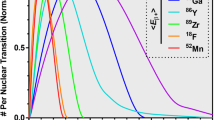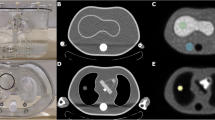Abstract
The influence of the positron distance of flight in various human tissues on the spatial resolution in positron emission tomography (PET) was assessed for positrons from carbon-11, nitrogen-13, oxygen-15, fluorine-18, gallium-68 and rubidium-82. The investigation was performed using the Monte Carlo code PENELOPE to simulate the transport of positrons within human compact bone, adipose, soft and lung tissue. The simulations yielded 3D distributions of annihilation origins that were projected on the image plane in order to assess their impact on PET spatial resolution. The distributions obtained were cusp-shaped with long tails rather than Gaussian shaped, thus making conventional full width at half maximum (FWHM) measures uncertain. The full width at 20% of the maximum amplitude (FW20M) of the annihilation distributions yielded more appropriate values for root mean square addition of spatial resolution loss components. Large differences in spatial resolution losses due to the positron flight in various human tissues were found for the selected radionuclides. The contribution to image blur was found to be up to three times larger in lung tissue than in soft tissue or fat and five times larger than in bone tissue. For 18F, the spatial resolution losses were 0.54 mm in soft tissue and 1.52 mm in lung tissue, compared with 4.10 and 10.5 mm, respectively, for 82Rb. With lung tissue as a possible exception, the image blur due to the positron flight in all human tissues has a minor impact as long as PET cameras with a spatial resolution of 5–7 mm are used in combination with 18F-labelled radiopharmaceuticals. However, when ultra-high spatial resolution PET cameras, with 3–4 mm spatial resolution, are applied, especially in combination with other radionuclides, the positron flight may enter as a limiting factor for the total PET spatial resolution—particularly in lung tissue.



Similar content being viewed by others
References
Chatziioannou AF, Cherry SR, Shao Y, Silverman RW, Meadors K, Farquhar TH, Pedarsani M, Pheps ME. Performance evaluation of microPET: a high-resolution lutetium oxyorthosilicate PET scanner for animal imaging. J Nucl Med 1999; 40:1164–1175.
Melcher Cl. Scintillation crystals for PET. J Nucl Med 2000; 41:1051–1055.
Brix G, Zaers J, Adam LE, Bellemann ME, Ostertag H, Trojan H, Haberkorn U, Doll J, Oberdoifer F, Lorenz WJ. Performance evaluation of a whole-body PET scanner using the NEMA protocol. National Electrical Manufacturers Association. J Nucl Med 1997; 38:1614–1623.
Adam LE, Karp JS, Daube-Witherspoon ME, Smith RJ. Performance of a whole-body PET scanner using curve-plate NaI(Tl) detectors. J Nucl Med 2001; 42:1821–1830.
Moses WW, Virador PRG, Derenzo SE, Huesman RH, Budinger TF. Design of a High-resolution, high-sensitivity PET camera for human brains and small animals. IEEE Trans Nucl Sci 1997; NS-44:1487–1491.
Budinger TH. PET instrumentation: what are the limits? Semin Nucl Med 1998; 3:247–267.
Derenzo SE. Precision measurement of annihilation point distributions for medically important positron emitters. In: Positron annihilation. Sendai, Japan: The Japan Institute of Metals; 1979:819–823.
Cho ZH, Chan JK, Eriksson L, Singh M, Graham S, MacDonald NS, Yano Y. Positron ranges obtained from biomedical important positron-emitting radionuclides. J Nucl Med 1975; 16:1174–1176.
Palmer MR, Brownell GL Annihilation density distribution calculations for medically important positron emitters. IEEE Trans Med Imaging 1993; 11:373–378.
Levin CS, Hoffman EJ. Calculation of positron range and its effect on the fundamental limit of positron emission tomography system spatial resolution. Phys Med Biol 1999; 44:781–799.
Baró J, Sempau J, Férnandez-Varea JM, Salvat F. PENELOPE: an algorithm for Monte Carlo simulation of the penetration and energy loss of electrons and positrons in matter. Nucl Instrum Meth 1995; B100:31–46.
Sampau J, Acosta E, Baró J, Fernández-Varea JM, Salvat F. An algorithm for Monte Carlo simulation of coupled electron-photon transport. Nucl Instrum Meth 1997; B132:377–390.
Salvat F, Fernández-Varea JM, Acosta E, Sempau J. PENELOPE, a code system for Monte Carlo simulation of electron and photon transport. OECD/NEA 5–7 November 2001, NEA/NSC/DOC(2001)19. ISBN: 92–64–18475–9
ICRU. International Commission on Radiation Units and Measurements. Photon, electron, proton and neutron interaction data for body tissues. 1992: Report 46.
ICRP. International Commission on Radiological Protection. Reference man: anatomical, physiological and metabolic characteristics. ICRP Publication 23. New York: Pergamon Press, 1975.
Cross WG, Ing H, Freedman N. A short atlas of beta-ray spectra. Phys Med Biol 1983; 28:1251–1260.
Bielajew AF, Hirayama H, Nelson WR, Rogers DWO. History, overview and recent improvements of EGS4. Report NRCC/PIRS-0436, June 1994.
Haber SF, Derenzo SE, Uber D. Application of mathematical removal of positron range blurring in positron emission tomography. IEEE Trans Nucl Sci 1990; NS37:1293–1299.
Acknowledgements
We are grateful to Dr Stephen M. Seltzer from the National Institute of Standards and Technology, Gaithersburg, USA, for providing calculated beta energy spectra. This work was funded by the Karolinska Hospital FoUU of the Stockholm Country Council.
Author information
Authors and Affiliations
Corresponding author
Rights and permissions
About this article
Cite this article
Sánchez-Crespo, A., Andreo, P. & Larsson, S.A. Positron flight in human tissues and its influence on PET image spatial resolution. Eur J Nucl Med Mol Imaging 31, 44–51 (2004). https://doi.org/10.1007/s00259-003-1330-y
Published:
Issue Date:
DOI: https://doi.org/10.1007/s00259-003-1330-y




